A glimpse into the mythical world
Let's look at some of the world's mythology from whence so many talented authors have dipped their cups and drunk from.
Introducing the Phoenix
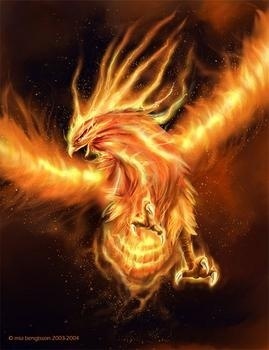
The mythological Phoenix can be found in the mythologies of the Persian, Greeks, Romans, Egyptians, Chinese, and Phoenicians.
A phoenix is a mythical bird that is a fire spirit with a colorful plumage and a tail of gold and scarlet or purple, blue, and green according to some legends. It has a 500 to 1000 year life-cycle, near the end of which it builds itself a nest of twigs that then ignites both the nest and bird from which a new phoenix or phoenix egg is born.
[image error]
Some legends believe they are immortal, some believe they have off spring, and in Egypt, they believe the ashes of the old self are made of myrrh and deposits it in the Egyptian city of Heliopolis (literally "sun-city" in Greek). It is sad that the bird's cry is that of a beautiful son. In some stories they are able to change their form to that of a human.

The Story of the Phoenix
There is a bird that lays no eggs and has no young. It was here when the world began and is still living today, in a hidden, faraway desert spot. It is the phoenix, the bird of fire.
One day in the beginning times, the sun looked down and saw a large bird with shimmering feathers. They were red and gold--bright and dazzling like the sun itself. The sun called out, "Glorious Phoenix, you shall be my bird and live forever!" Live forever!
The Phoenix was overjoyed to hear these words. It lifted its head and sang, "Sun glorious sun, I shall sing my songs for you alone!"
But the Phoenix was not happy for long. Poor bird. Its feathers were far too beautiful. Men, women, and children were always casing it and trying to trap it. They wanted to have some of those beautiful, shiny feathers for themselves.
"I cannot live here," thought the phoenix. and it flew off toward the east, where the sun rises in the morning.
The Phoenix flew for a long time, and then came to a far away, hidden desert where no humans lived. And there the phoenix remained in peace, flying freely and singing its songs of praise to the sun above.
Almost five hundred years passed. The Phoenix was still alive, but it had grown old. It was often tired, and it had lost much of its strength. It couldn't soar so high in the sky, nor fly as fast or as far as it was young.
"I don't want to live like this," thought the Phoenix. "I want to be young and strong."
So the Phoenix lifted it's head and sang, "Sun, glorious sun, make me young and strong again!" but the sun didn't answer. Day after day the Phoenix sang. When the sun still didn't answer, the Phoenix decided to return to the place where it had lived in the beginning and ask the sun one more time.
It flew across the desert, over hills, green valleys, and high mountains. The journey was long, and because the Phoenix was old and weak, it had to rest along the way. Now, the Phoenix has a keen sense of smell and is particularly fond of herbs and spices. So each time it landed, it collected pieces of cinnamon bark and all kinds of fragrant leaves. It tucked some in among its feathers and carried the rest in its claws.
When at last the bird came to the place that had once been its home, it landed on a tall palm tree growing high on a mountainside. Right at the top of the tree, the Phoenix built a nest with the cinnamon bark and lined it with the fragrant leaves. Then the Phoenix flew off and collected some sharp-scented gum called myrrh, which it had seen oozing out of a nearby tree. The Phoenix made an egg from the myrrh and carried the egg back to the nest.
Now everything was ready. The Phoenix sat down in its nest, lifted its head, and sang, "Sun, glorious sun, make me young and strong again!"
This time the sun heard the song. Swiftly it chased the clouds from the sky and stilled the winds and shone down on the mountainside with all its power.
The animals, the snakes, the lizards, and every other bird hid from the sun's fierce rays -- in caves and holes, under shady rocks and trees. Only the Phoenix sat upon its nest and let the suns rays beat down upon it beautiful, shiny feathers.
Suddenly there was a flash of light, flames leaped out of the nest, and the Phoenix became a big round blaze of fire.
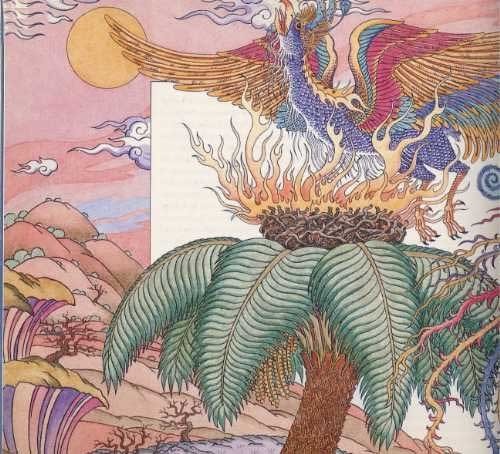
After a while the flames died down. The tree was not burnt, nor was the nest. But the Phoenix was gone. In the nest was a heap of silvery-gray ash.
The ash began to tremble and slowly heave itself upward. From under the ash there rose up a young Phoenix. It was small and looked sort of crumpled, but it stretched its neck and lifted its wings and flapped them. Moment by moment it grew, until it was the same size as the old Phoenix. It looked around, found the egg made of myrrh, and hollowed it out. Then it placed the ashes inside and finally closed up the egg. The young Phoenix lifted its head and sang, "Sun, glorious sun, I shall sing my songs for you alone! Forever and ever!"
When the song ended, the wind began to blow, the clouds came scudding across the sky, and the other living creatures crept out of their hiding places.
Then the Phoenix, with the egg in its claws, flew up and away. At the same time, a cloud of birds of all shapes and sizes rose up from the earth and flew behind the Phoenix, singing together, "You are the greatest of birds! You are our king!"
The birds flew with the Phoenix to the temple of the sun that the Egyptians had built at Heliopolis, city of the sun. Then the Phoenix placed the egg with the ashes inside on the sun's altar.
"Now," said the Phoenix, "I must fly on alone." And while the other birds watched, it flew off toward the faraway desert.
The Phoenix lives there still. But every five hundred years, when it begins to feel weak and old, it flies west to the same mountain. There it builds a fragrant nest on top of a palm tree, and there the sun once again burns it to ashes. But each time, the Phoenix rises up from those ashes, fresh and new and young again.
Introducing our next mythological creature,is > El Naddaha
[image error]
The legend of El Naddaha (translated: the caller) is somewhat a modern legend about a female sea nymph-like genie, or more commonly referred to as a water spirit. Known as Ginneyya in Egyptian Arabic, she calls men to the Nile, most likely to their death. It is quite popular in the Nile Delta, the northern agricultural-based area of Egypt, typically north to Cairo, where the Nile constitutes a main part of the environment.
History
is unknown when exactly the legend was first told, or what was the incident that caused its rise. The story became popular around the 1950s where people would spend a lot of time by the Nile. The children would play by its shores after school and young men would hang there at night.
[image error]
The legends tells the story of an amazingly beautiful female who appears to men walking by the Nile at night. The creature calls a man by name, rendering him speechless, hypnotized, and obediently follows her voice. Most are not able to see her until they are close enough to the Nile. She is described as a very beautiful white female; tall, slender, and with long flowing hair down her back. She stands at the edge of the river in a flowing white semi-transparent dress. Some believe she has a semi-transparent body and is thought by many to be a genie.
In rural Egypt, the men may be called to from their homes while asleep in bed. The affected man may eagerly attempt to go out for her while others would not immediately try to find her. Rather, he'd enter a state of disturbed consciousness for a few nights, after which he would eventually leave late at night. People in rural Egypt believe that a man who is called for by El Naddaha is doomed, curing him from the curse is impossible. Many old citizens believe she consumes or fiercely pulls her victims into the Nile and drowns them. And, the dead tell no tales.
< /span>[image error]
And, the third mythological creature for this blog is, the Kappa .
A Kappa is a dwarf-like water demon of Japan that resembles a shriveled old-man, with webbed hands and feet, sporting a tortoise shell. An origin for the demons could be they are the ghosts of drowned souls. Any pond or river may have one. They possess immense strength and can easily overpower a human. Although the source of this power comes from the stored water within the dish on their head.
Kappa are typically depicted as a humanoid form and are the size of a child. They have scaly, reptilian skin ranging in color from yellow to green or blue, and have webbed hands and feet. They supposedly inhabit the ponds and rivers of Japan and possess great skills in swimming and wrestling. They are known as pranksters but are devilishly cunning. They can speak and communicate with humans. It is said they take their victims and drown them. Then they drink their blood, eat their livers and gain greater powers by consuming their very souls.
It was believed that if confronted with a kappa there were few means of escape: Kappa, for one reason or another, obsess over being polite, so if a person were to gesture a deep bow to a kappa it would more than likely return it. In doing so, the water kept in the lilypad-like bowl on their head would spill out and the kappa would be rendered unable to leave the bowed position until the bowl was refilled with water from the river in which it lived. If a human were to refill it, it was believed the kappa would serve them for all eternity. A similar weakness of the kappa in some tales are their arms, which can be easily pulled from their body. If their arm is detached, they will perform favors or share knowledge in exchange for its return. Once the kappa is in possession of its arm it can then be reattached. Another method of defeat involves the kappa and their known love of wrestling. They will sometimes challenge those they encounter to wrestle or other various tests of skill. This tendency is easily used against them just as with the bow, by encouraging them to spill the water from their sara. They will also accept challenges put to them, such as in the tale of the farmer's daughter who was promised to a kappa in marriage by her father in return for the creature irrigating the land. She challenged it to submerge several gourds in water and when it failed in its task, it retreated and she was saved from the promised marriage. Kappa have also had an aversion to iron, sesame and ginger.
Kappa are not entirely antagonistic to humankind, however. They are curious and may even befriend human beings in exchange for gifts and offerings. Their favorite meal being small children.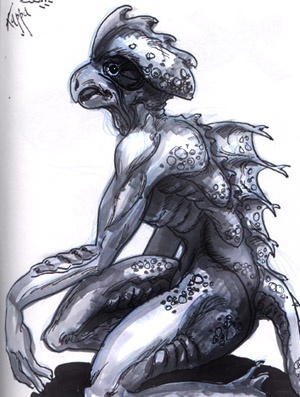
(This image inspired Houck's version of a Kappa in her Tiger series though hers are a bit more frightening!)
Another interesting characteristic is its knowledge of healing medicines and legend states that they are responsible for teaching humans the art of bone setting, for the healing of broken bones. 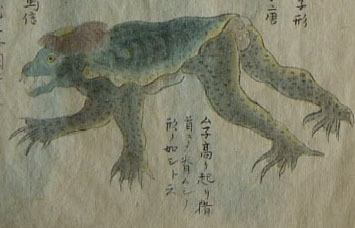
Some even go as far as to say that this myth is the source of inspiration used in the popular Nintendo Game, Super Mario Brothers. It is said that the "koopas" in the game are based on these creatures and the mountain with its peak filled with water is "Kappa Mountain".
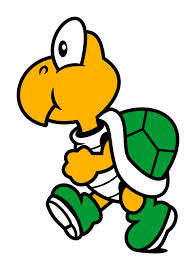
Well, there you have it. The featured mythological creatures for this week. If you have a particular mythological creature or legend you'd like featured on this web site, feel free to leave a comment and we just may include it in our next featured blog about world mythology! As always, a huge THANK YOU for all your continued support for Colleen Houck's book series! I for one CAN'T WAIT to read her new book series!!!
Till next time!
 newest »
newest »
 You had me at "mythical", Colleen...have loved mythology since I read Mythology by Edith Hamilton at age 11; thanks!
You had me at "mythical", Colleen...have loved mythology since I read Mythology by Edith Hamilton at age 11; thanks!





